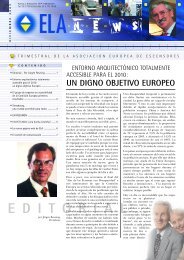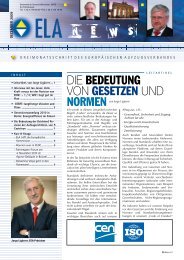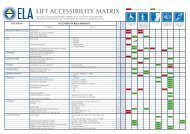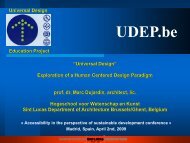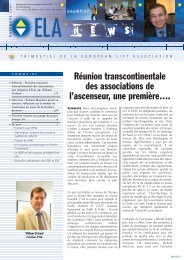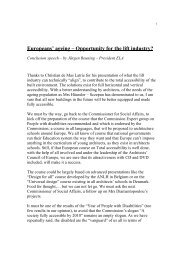WP6-Brochure-E4 brochure - ELA European Lift Association.
WP6-Brochure-E4 brochure - ELA European Lift Association.
WP6-Brochure-E4 brochure - ELA European Lift Association.
You also want an ePaper? Increase the reach of your titles
YUMPU automatically turns print PDFs into web optimized ePapers that Google loves.
preventing the car from falling. Typically, the generated (braking) power in the motor is<br />
dissipated in a resistance, returned to the main supply naturally, if the motor, acting as a<br />
generator, is directly connected to the grid or, depending on the topology, some VVVF drives<br />
also allow the braking energy to be injected back to the power network.<br />
In some countries there are restrictions on the injection of power into the distribution<br />
network. Even in these cases, regenerative braking should not pose a problem, since the total<br />
load of the building (computers, servers, lighting, HVAC) will be higher than the peak power<br />
injected by a lift.<br />
Line side converter<br />
L<br />
Machine side converter<br />
Line<br />
C<br />
R d<br />
AC<br />
Motor<br />
T d<br />
Figure 3‐11. Topology of a VSD‐PWM with dissipation resistance (Rd) (source: ISR‐UC)<br />
Figure 3‐12. Topology of a VSI‐PWM with regenerative capacity and power factor control (source: ISR‐UC)<br />
When the lift is going down, and the load weight (people inside) is larger than the<br />
counterweight, then the motor torque is in opposite direction to the speed, i.e., the motor is<br />
braking. In the same way, when the lift is going up unloaded, energy savings can be reached if<br />
the motor is controlled with a regenerative VVVF drive.<br />
Theoretically, if there were no losses, the regenerated energy would be equal to the motoring<br />
energy. However, there are still losses due to the existence of friction losses (e.g. friction in the<br />
guide rails, air resistance), motor losses (e.g. the copper losses, the iron losses and the friction<br />
and windage losses) and, in geared systems, losses in the gearbox (this is especially significant<br />
in systems equipped with worm gears where the efficiency in the reverse direction is<br />
considerably lower than in the forward direction).<br />
Because it adds a significant cost to the installation, regeneration is not always cost‐effective,<br />
especially with reduced traffic in low‐ and mid‐rise buildings.<br />
25





